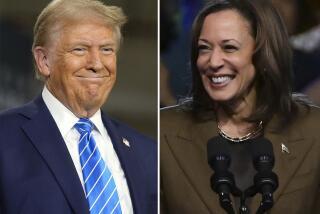Polls 2020: As Biden, Trump begin debates, the races in battleground states are tight

- Share via
WASHINGTON — When President Trump and former Vice President Joe Biden butt heads during Tuesday night’s presidential debate, they will be hoping to win support from some of the millions of Americans who will be watching.
Yet the fact is, many of the country’s votes are already effectively out of contention. Barring some unforeseeable cataclysm, blue states will vote for Biden, and red states will vote for Trump. That’s why you rarely hear about presidential candidates campaigning in Hawaii or Wyoming — or California (except to raise money in the Golden State). It’s not worth expending time and resources for electoral votes effectively guaranteed to one party.
For a high-profile event like a debate — much like each party’s convention — the candidates are thinking about winning over the relatively few undecided or persuadable voters in the minority of too-close-to-call states.
In 2020, many of those close ones are in the Midwest.
Looking at a flurry of polls conducted from mid-September through last week, one gets a sense of the electoral backdrop — and Biden’s slight edge — going into the first of three debates. In national polls, Trump is on his back foot, trailing by between 6 and 10 points. More worrisome for him, he’s behind in key states — many of them in the Great Lakes region and the industrial belt from Pennsylvania to Wisconsin — that Barack Obama won in 2008 and 2012 but Trump won in 2016, enabling his surprise victory over Hillary Clinton.
If Biden can bring the region back into the Democrats’ coalition, he could well win, and Trump’s victories there four years ago will seem an aberration. If not, it could confirm a realignment away from Democrats in the region, owing to defections among non-college-educated, working-class, white voters.
While Democrats had all but given up on Republican-leaning Ohio as the campaign began, its 18 electoral votes are balanced on a knife’s edge right now. Among likely voters, Quinnipiac University identified a dead heat: Biden 48%, Trump 47% — a split that’s within the poll’s 3-percentage-point margin of error. Fox News found a wider but still not decisive split in the state of 50% for Biden and 45% for Trump, also among likely voters and with a 3-point margin of error.
In Michigan, Biden was up 8 points over Trump, 52% to 44%, a new NBC News/Marist poll found — but again, that’s with a 4.3-point margin of error. His edge was slightly greater in Wisconsin, where NBC/Marist reported a 10-point Biden lead (54% to Trump’s 44%).
A poll in coveted Pennsylvania, taken through the weekend and released Monday by the New York Times and Siena College, had Biden maintaining a lead over Trump of 49% to 40% among likely voters. An earlier Fox poll in the state put Biden ahead 51% to 44%, and a third survey, by Franklin & Marshall College, found a similar split: Biden’s 48% to Trump’s 42%. (If Biden beats Trump in Pennsylvania, it will be a return to form; except for 2016’s Trump upset, the state has gone for the Democrat in every presidential election since 1992.)
Iowa, which had seemed to be trending for Trump, instead remains close. A poll by the New York Times and Siena College found a 45%-42% split in Biden’s favor, with a 4.9-point margin of error.
Tight races elsewhere, especially in the Southeast, could also determine which candidate gets the 270 electoral votes necessary to win.
Polling conducted last week in North Carolina found Biden ahead of Trump 48% to 46%, according to CBS News and YouGov. But given the margin of error and a polling sample of registered rather than likely voters, that snapshot doesn’t do much more than affirm the dead heat that an Emerson College poll identified in the state last week.
Similarly in Georgia, another survey conducted last week by the same pollsters put Trump right ahead of Biden but in a statistical tie, 47% to 46%, also among registered voters. Last week, Monmouth University found the same split among registered Georgia voters.
North Carolina and Georgia represent a different dynamic than that of the Midwestern states. Each has gone blue just once in the last four decades. For either to flip for Biden would mean that Trump’s Republican base has eroded, Biden has attracted new voters or both.
For many Los Angeles Times readers, of course, the question of how California goes is no question at all. A poll of blue California released Friday by UC Berkeley’s Institute of Governmental Studies found 67% support for Biden and 29% for Trump.
More to Read
Get the L.A. Times Politics newsletter
Deeply reported insights into legislation, politics and policy from Sacramento, Washington and beyond. In your inbox twice per week.
You may occasionally receive promotional content from the Los Angeles Times.











